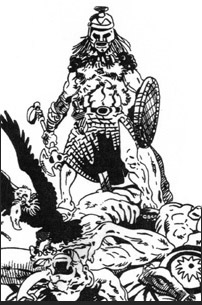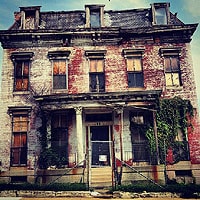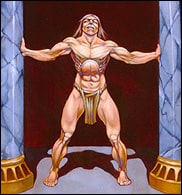From the 370s thru the 470s Rome’s fortunes waned continuously. The lively, pleasing and entertainingly footnoted History of Edward Gibbon, has risen to be my very favorite work of investigative narration. [0] I recommend Gibbon’s narration, either in the 1990s Literary Guild slip cover edition of 8 books, or, the reading by Mister David Timpson. I would like to confine my treatment to impressions of:
Ethnicity,
Personality,
Masculinity,
Cruelty,
Degeneracy,
Piety,
Primacy,
The World Stage…
In inverted order, in something like Gibbon described as a “disquisition.”
The World Stage was increasingly cool and harsh, with frequent earthquakes, increased famine and disease and intensified migrations of barbarians from east and north. Coinage had been devalued and the economy had devolved into a scramble to cannibalize the accumulated art and architecture of Antiquity: relics, even guilt roof tiles, church chalices and temple eves were melted into bullion as the coinage was debased, and the lack of ability to quarry stone turned the eye of the degenerate civic architect on the monuments of a superior past as a source of ready stone. Whatever economic undercurrent, whatever network of nameless and faceless bankers and soul drivers who had trafficked in precious metals and human property since the Bronze Age, remained implicitly intact. For the only social mechanics that yet functioned as they once had was liquidation of gold, silver and people into movable assets.
The rhythmic use of the sorrowful quip in the face of hideous politics and religious hysterics serves the author as a light balm:
“Arcadius, in the thirty fifth year of his age, after a reign—if we can abuse that word…” gives a nice example of Gibbon’s sense of humor that makes his work so pleasing.
Primacy
Emperors served increasingly as disposable puppets for conspiracies. Generals are murdered for their success as often as in the pagan Roman past, with the key civic trait of the Roman government maintaining itself as the hatred of the successful military man. The quickening heart of the collective soul, and its cancerous body, came increasingly to identify and look to barbarian warriors instead of Roman soldiers, heroes and chiefs as agents and of Kings as protectors. The ancient Arуan ideal of the King, after an absence of 1,200 years on the shores of the decadent Middle Sea had returned. The Medieval and Early Modern ideal of the King [Arthur being the ideal] came only from the barbarians, even as the modern idea of the puppet executive is an obvious resurrection of Roman corruption.
Piety
Pious pagans remained in intellectual and military service to Christian Rome more than 100 years after Constantine stamped the Christian brand on the empire. Many of the barbarians were Christian, and were no less cruel than their heathen relations. Christian piety chiefly expressed itself in the persecution of rival Christian sects, with pagans receiving better treatment then “heretics,” whose doctrines were often so similar to that of their orthodox and heretical foes that one would “require a theological microscope” to discern the difference. Mass conversion of rural pagans, which included monks employing gladiators to slaughter rural folks for maypole ceremonies and such, resulted in a mass swelling of church membership. Not coincidentally, the worship of the physical remains of saints, martyrs and apostles became a rage at this time, so morbid that one newly deceased bishop’s body had to be guarded, lest the faithful tear it apart for relics.
Degeneracy
The switch to Christianity did not, halt, slow or accelerate the increased sexual perversion of Late Antiquity, or the decreased birthrate. When the Vandals sacked Carthage in 429 there were many Roman men dressed as women, complicating the sorting of slave girls. Romans of Latin, Greek and other blood, any Roman by name it seems, lacked a healthy desire to procreate as well as to fight enemies. Nearly all military affairs were conducted and directed by barbarians.
Cruelty
Christianity likewise did nothing to change the cruel nature of Roman collective consciousness, with delight in torture, mob murder and the slaughter of the innocent relations of any man who fell from public favor remaining the status quo. Attila the heathen Hun and Odaca the barbarian-Christian Heruli King both showed much more mercy than Christian Romans. Indeed, the storied cruelty of the Christian Barbarian Vandals, seems to be due to their alliance with Donatist Christians paying off scores against Catholics in and around Carthage. Overall, the cruelty once reserved by pagan Romans for the slaughter of the women of foes, was now transferred to the slaughter of barbarian women and children by Romans, and of Christian by Christian over doctrine. The protection of the Church was strictly limited to upper class, Christian, Roman women.
Masculinity
At the midpoint of this period, three women ruled the Roman world as regents to sissy emperors, either sons or brothers. Some strongmen did rise to power, a few Roman soldiers, who were murdered, especially after becoming emperors, and numerous barbarian kings. These barbarian kings were the only protectors of women on the world stage. Even after Attila killed his brother Bleda, Bleda’s widow was an honored matron of that nation. Placidia, a conniving bitch, if a beauty, would be rescued by and married by two barbarian kings and one soldier king. The daughter of Eudocia, disgraced empress of the Eastern Empire, was twice rescued by Genseric, King of the Vandals, who married one of her daughters to a son of his. The only masculine figure permitted in Rome, as a defender of the weak and innocent, was Jesus Christ, with women who would have been killed in the pagan period permitted to live on as a nun. But Roman men themselves, had lost along with the desire to procreate, the instinct to protect even their own wives and daughters.
Personality
Attila, King of the Huns, only man to rule the Scythians and the Germans, managed to put together the biggest battle in pre-gunpowder warfare at Chalons, in which most barbarian nations and some skittish Romans fought. He was like a force of nature, destroying 70 eastern cities and a dozen or so cities in Northern Italy, resulting in Venice, birthing by his rapine a Republic as the people of that region fled to and settled on estuary islands. Of the four kings to bring the City of Rome to its knees, he is the only one who did not rape, burn, loot and destroy it. Asiatic in appearance, he was culturally Scythian, living and dying in all the traditional manners described by Herodotus and dscovered in Scythian burial mounds in Siberia.
Aetius, a friend and rival of Attila, was one of the last true Roman statesman/soldiers and was involved in an early lance duel with Saint Boniface, which he won by using a longer spear. Genseric the Vandal, born on the Baltic, adventured through Germany, Gaul, Spain and into North Africa, which he conquered and held against superior forces. [2] An Arrian Christian, he became the first “Barbary pirate” terrorizing and ravaging from Spain to Egypt, raiding Italy annually. This ally of Attila used the King of the Huns as a capital piece in his chess match to destroy the Roman world, and keeping his own council, even declining to give his navigators targets, trusting to God to send winds that would bring his fleets, which transported horses for inland raiding, to “the guilty.” Attila was the most powerful, Aetius the most crafty, but Genseric was a king for some 50 years, leading his men in war into his 80s, having played his foes and allies off against each other masterfully.
Ethnicity
Some Asiatic races such as the Turkalingi, Uigars and Avars were already in Europe raiding, serving as mercenaries and even attacking the Huns and Germans. The Huns were certainly the Scythians of Classical Antiquity having interbred extensively with as many races as possible. Such names as Uldin, Onagesius, Scota, Erlak [1], Dengezik [1], Edacom, Eslaf, Eonak [1] and Attila’s father, Mujuk, show a mixture of Tartar, Turkic and Germanic names. As with the tribes of North America, adoption of valiant men and the acquisition of varied slave women and wives suggests the Huns as an actual force of interbreeding nature.
By 476 to 479, Rome had been raped three times and submitted once since 405, and was now utterly gone, but for the memory of its 1200 years of rule and its remarkable reputation for being, among nations, the most systematically cruel.
…
Notes
-0. While discussing the physical fate of the city of Rome, Gibbon admits that his history began as an inquiry into that much smaller subject, this great history having radiated out from that urban inquiry.
-1. Three slain sons of Attila, who had two short lived and one moderate terms of tribal kingship after his passing. It seems that the mothers must have named Hun sons according to the conventions of their people, and that these people were varied, for Attila actually fought wars to attain choice brides of various races.
-2. Gibbon confidently declared, in 1777, that no barbarian would even consider the wasted effort of conquering the black regions south of the Torrid Zone! He would have been horrified to know that Europe would lose 100 million souls in two wars that began over the scramble for possession of Sub Sahara Africa.











